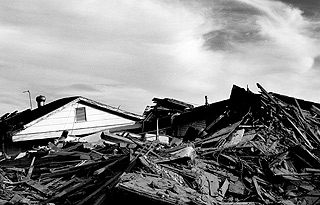Novelist Elizabeth McCracken is just back from New Orleans, where she was a writer-in-residence at the Newcomb Institute. She traveled with her husband, Edward Carey, and with Gourmet correspondent Ann Patchett. This post is the second in a series. You can read part one here.
It doesn’t take much to get New Orleanians to talk about Katrina and ever-after-Katrina—what they lost, what they worry about, the people they know who lost everything, the people they know who lost nothing except their homeowners insurance and therefore are nearly guaranteed to lose everything sometime in the future, the incompetence of government at every level, the uncertainty of the crime and the unrepaired levees. Someone explained it to me: New Orleanians aren’t suffering from post-traumatic stress disorder, they’re suffering from current, ongoing traumatic stress disorder.
People who’d heard I was going to New Orleans had said, "I hear there are a lot of parts of the city that weren’t affected by the flooding." That’s what I’d thought, too. Once you’re there you can see how impossible it is, the idea that any part of the city wasn’t affected.

The city feels, above all, melancholy. I just kept thinking about all those empty houses—the little ones in the Lower Ninth, the larger ones in Lakeview, the colossal ones with for-sale signs uptown. Where did all those people go? It feels presumptuous to type this, but it’s hard for even a visitor not to miss those people. The streets are full of longing.
But let me end with one of the best nights. My husband and I and my old friend Tom went to a bar called Mimi’s in the Marigny, not too far from Helen Hill and Paul Gaulianus’s house. We went upstairs and ate tapas and listened to Gypsy jazz and watched a bunch of preposterously drunk young women dance. They danced every dance they’d ever learned, weird ballet turns from elementary school and out-of-sync hip-hop moves cribbed from videos and parodic tangos with each other that they clearly meant to be sexy but seemed, frankly, Three Stooges—flavored. An older man who looked a lot like one of my Jewish great-uncles sat down in a chair a little bit away from the rest of the band. He opened a small case, looked in, and closed it. The drunk girls kept almost accidentally sitting on his lap. Finally, he removed a cornet from the case and played inwith the band—he wasn’t a random audience member after all!—but the drunk girls didn’t care, they just kept spinning within inches of the bell of his horn until he was moved into the bosom of the band for his own protection. The drunk girls began to bump and grind with one another, looking over their shoulders at the boys they’d come with.
Then, in one of those moments of barroom beauty, two relatively sober women in their late 30s or early 40s—an actual romantic couple—got up to dance in their smart black suits and showed us all what sexy was. Once or twice, a drunk girl unsteadily boogied into their orbit but got bucked away by pure authenticity. I’d been feeling both young and old all night, happy to be in a raucous bar, remembering the days when I might have been one of those drunk girls—not that I would have danced with that much menace, but I remember being intoxicated with lots of things, working very hard to look as though I didn’t have a care in the world. That night in New Orleans, I was driving, and so I hopped up only on very nice tapas. The triumph of the black-suited women did me a lot of good.
At the end of the night, my husband went up to the cornet player to shake his hand.
"Hey!" the cornet player said to another band member. "Didn’t he look exactly like Mad Bottom?" Mad Bottom turned out to be another New Orleans cornet player. "I swear," said this cornet player to my delighted English husband, "you could be Mad Bottom’s twin!" So there you go. New Orleans is still the place where you find out that you have a doppelganger and feel lucky—but somehow unsurprised—to learn that his name is Mad Bottom.


 Pinterest
Pinterest


